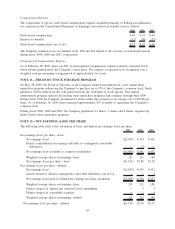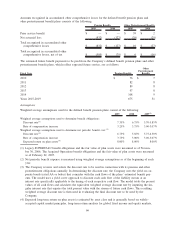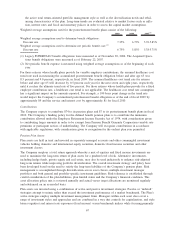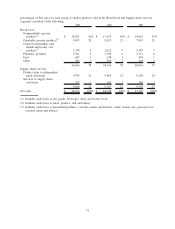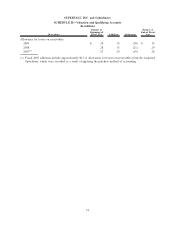Albertsons 2009 Annual Report Download - page 75
Download and view the complete annual report
Please find page 75 of the 2009 Albertsons annual report below. You can navigate through the pages in the report by either clicking on the pages listed below, or by using the keyword search tool below to find specific information within the annual report.to significantly reduce contributions, exit certain markets or otherwise cease making contributions to these
plans, it could trigger a partial or complete withdrawal that would require the Company to fund its
proportionate share of a plan’s unfunded vested benefits.
The Company also makes contributions to multi-employer health and welfare plans in amounts set forth in the
related collective bargaining agreements. A small minority of collective bargaining agreements contain reserve
requirements that may trigger unanticipated contributions resulting in increased healthcare expenses. If these
healthcare provisions cannot be renegotiated in a manner that reduces the prospective healthcare cost as the
Company intends, the Company’s Selling and administrative expenses could increase in the future.
NOTE 15—SHAREHOLDER RIGHTS PLAN
On April 24, 2000, the Company announced that the Board of Directors adopted a Shareholder Rights Plan
under which one preferred stock purchase right is distributed for each outstanding share of common stock. The
rights, which expire on April 12, 2010, are exercisable only under certain conditions, and may be redeemed by
the Board of Directors for $0.01 per right. The plan contains a three-year independent director evaluation
provision whereby a committee of the Company’s independent directors will review the plan at least once
every three years. The rights become exercisable, with certain exceptions, after a person or group acquires
beneficial ownership of 15 percent or more of the outstanding voting stock of the Company.
NOTE 16—SEGMENT INFORMATION
Refer to the Consolidated Segment Financial Information for financial information concerning the Company’s
operations by reportable segment.
The Company’s operating segments, as defined by SFAS No. 131, “Disclosures about Segments of an
Enterprise and Related Information,” reflect the manner in which the business is managed and how the
Company allocates resources and assesses performance internally.
Our chief operating decision maker is our Chairman and Chief Executive Officer. The Company offers a wide
variety of grocery products, general merchandise and health and beauty care, pharmacy, fuel and other items
and services. The Company’s business is classified by management into two reportable segments: Retail food
and Supply chain services. These reportable segments are two distinct businesses, one retail and one wholesale,
each with a different customer base, marketing strategy and management structure. The Retail food reportable
segment is an aggregation of the Company’s retail operating segments, which are primarily organized based on
geography.
The Retail food operating segments are aggregated as the products sold in the grocery stores are substantially
the same, focusing on food and related products; the customer or potential customer for each of the retail
operating segments is the same, any consumer of food and related products; each of the retail operating
segments use the same distribution method for its products, the sale of items through grocery stores; and all of
the Company’s retail operating segments are subject to similar regulation. Additionally, the retail operating
segments are aggregated into one Retail food reportable segment as they have similar economic characteristics
and are expected to have similar long-term financial performance, based on operating earnings as a percent of
sales.
The Retail food reportable segment derives revenues from the sale of groceries at retail locations operated by
the Company (both the Company’s own stores and stores licensed by the Company). The Supply chain
services reportable segment derives revenues from wholesale distribution to independently owned retail food
stores, mass merchants and other customers (collectively referred to as “independent retail customers”) and
logistics support services.
The Company offers a wide variety of nationally advertised brand name and private brand name products,
primarily including grocery (both perishable and nonperishable), general merchandise and health and beauty
care, pharmacy and fuel, which are sold through the Company’s own and licensed retail food stores to
shoppers and through its Supply chain services business to independent retail customers. The amounts and
71




